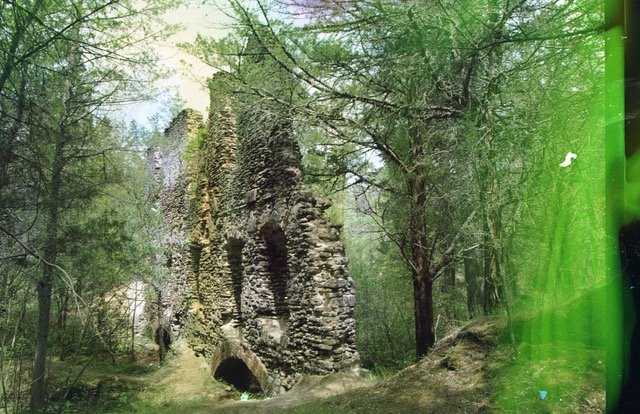
Ashley Darrow & Lauren Seyler
Emanations from an Iron Bog
The New Jersey Pine Barrens is a one-million acre patch of nutrient-poor sand dominated by pitch pines, oaks, and cedar swamps. Its darkly-colored, acidic waterways are rich in iron and provide the perfect conditions for the formation of limonite “bog iron” deposits. Bog iron supported a thriving ironworks industry in southern New Jersey throughout the 18th and early 19th centuries, which included the supply of munitions to the Continental Army during the Revolutionary War. Today the region is dotted with abandoned blast furnaces and ghost towns, remnants of a once-booming iron industry. Yet bog iron production persists, driven by the activity of ancient microorganisms. Microbes in the Pinelands use dissolved iron as a source of electrons, and in the process create twisted stalks, sheaths, and amorphous mats of iron (III) oxyhydroxide, from which bog iron is born. Bog iron seeps support thriving communities of microorganisms driven by the continual oxidation and reduction of iron. These communities exemplify the ways in which the transfer of electrons underpins the very fundamental and primal relationship between living cells and their nonliving habitats- the force connecting life to rock.
We journeyed into the Pine Barrens to document the iron bogs, the ruins surrounding them, and the scientific process of probing them. The resulting images were then developed in a “film soup” made using iron-rich, acidic water from the study site. Following in the footsteps of Jean Painlevé, these photographs approach biology as a mystery, with each unfolding fact revealing more about our absence of knowing than aggrandizing our stores of scientific knowledge. The bog iron seeps in the New Jersey Pine Barrens are tragically reduced by this perspective, which guides their observation. These slimes become confined to the status of “object” for the purposes of positivistic study, but this belies their true identities, as subjects older than anything the human would recognize as life. The images we present here pursue a collision and collusion between the hermeneutics of biology and those of photography, not as a rejection of either modality, but a visual experiment in their reunion.
Bog iron microorganisms act as psychopomps at the crossroads between the biological and geological worlds. The purpose of this project is to translate this relationship into the language of film. To do so requires that we treat the film medium as part of this biogeochemical blur, literally immersing the film into the primordial brew where the living and the nonliving communicate in a language older than human thought. The resulting images of the bogs, developed in those selfsame waters, look less purely like themselves and more like an imaginary of the Barrens - a dreamscape where art and science, life and nonlife, and the past and the future are indistinguishable. We return to the devil-haunted Pine Barrens encountering their iron bogs less as a quantifiable mass and more as a living eschatology. Our presence here marks a fresh approach to the honesty of their deterritorialization by the human subjective condition. What we find are endless facets; endless ways of stirring us to think, to feel, to know. A primordial future alongside one of our oldest living relatives.
Lauren Seyler (she/her) is a microbial ecologist and biogeochemist at Stockton University and Ashley Darrow (they/them) is a photographer and film critic based in Chicago. We developed this project in the hopes of demonstrating how the sciences and the humanities can both be used as tools to understand and explore the world, how each is incomplete without the other.